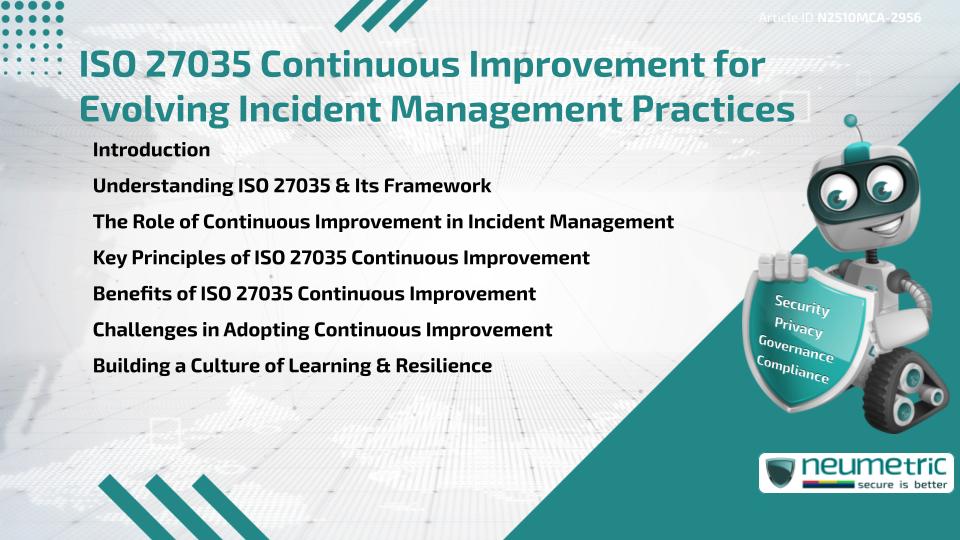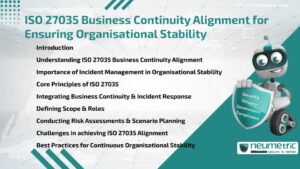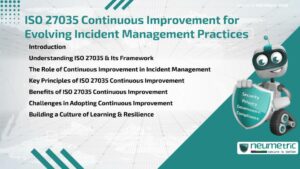Table of Contents
ToggleIntroduction
In the Age of constant Cyber Threats, Organisations must go beyond reactive Security. ISO 27035 Continuous Improvement offers a Systematic Framework for managing & improving Information Security Incidents. By combining Structured Response Procedures with ongoing learning, this Standard helps Organisations strengthen Resilience & Refine their Security Operations over Time. This article explains How ISO 27035 Continuous Improvement enhances Incident Management effectiveness in a rapidly evolving Digital Landscape.
Understanding ISO 27035 & Its Framework
ISO 27035, part of the ISO/IEC 27000 family, defines Best Practices for managing Information Security Incidents. It provides a Lifecycle that includes Preparation, Detection, Response & Post-incident learning. ISO 27035 Continuous Improvement emphasizes learning from every Incident, whether Minor or Major, to enhance Future Detection & Prevention.
For more information, visit the International organisation for Standardization.
The Role of Continuous Improvement in Incident Management
Continuous Improvement within ISO 27035 focuses on Feedback Loops & Iterative enhancement. After each Incident, Organisations perform detailed Post-event reviews to Identify Gaps, Root Causes & Areas for Procedural improvement. These lessons are then integrated into updated Policies, Training Sessions & Technical Controls, ensuring that the organisation becomes more resilient after every Event.
Learn more about improvement cycles at the NIST Computer Security Resource Center.
Key Principles of ISO 27035 Continuous Improvement
The ISO 27035 Continuous Improvement approach is grounded in Three (3) Principles: Prevention, Detection & Adaptation.
- Prevention: Strengthening controls & reducing Vulnerabilities.
- Detection: Enhancing monitoring & analysis for faster Identification of Incidents.
- Adaptation: Refining Processes & Response mechanisms based on Past experiences.
This cyclical Process ensures that Incident Management remains Dynamic & Responsive to evolving Threats.
Explore related Best Practices at the European Union Agency for CyberSecurity (ENISA).
Benefits of ISO 27035 Continuous Improvement
Implementing ISO 27035 Continuous Improvement offers multiple advantages. It enables faster Incident detection, reduces Downtime & Fosters a Culture of Accountability & Learning. The Process also ensures better coordination between Technical & Management teams, aligning Response efforts with Business Continuity Objectives. Ultimately, this Framework supports sustained organisational Maturity in CyberSecurity Management.
More about Best Practices can be found at the ISACA CyberSecurity Resources.
Challenges in Adopting Continuous Improvement
Organisations often struggle with inconsistent Data collection, limited Incident Documentation & Siloed Communication. Without Structured Post-incident reviews, Valuable lessons are lost. ISO 27035 Continuous Improvement addresses this by enforcing documentation Standards, root cause analysis & measurable Follow-up actions. However, success depends on executive support & continuous Staff Engagement.
Guidance on overcoming adoption barriers is available at the SANS Institute.
Building a Culture of Learning & Resilience
ISO 27035 Continuous Improvement extends beyond Compliance, it promotes an organisational mindset of Continuous learning. Incident Management teams regularly review & refine their Strategies, Integrating Insights from each Event. This fosters Resilience, ensures Regulatory alignment & strengthens confidence among Stakeholders & Customers.
Takeaways
ISO 27035 Continuous Improvement transforms Incident Management into a proactive, evolving practice. It helps Organisations identify weaknesses, implement stronger controls & maintain Operational continuity amid Cyber Threats. By embedding learning into every Incident, businesses create a cycle of Resilience & Readiness.
FAQ
What is ISO 27035 Continuous Improvement?
It is a Structured approach that enhances Incident Management by learning from past Incidents to prevent future ones.
How does ISO 27035 differ from other Frameworks?
It focuses specifically on the Incident lifecycle, emphasizing Continuous Improvement & Learning.
Is ISO 27035 applicable to all Organisations?
Yes, it applies to any organisation that handles Sensitive Information or requires Structured Incident Response.
How often should Reviews occur?
Reviews should follow every Incident & be conducted periodically to ensure process relevance.
Does ISO 27035 support CyberSecurity Maturity?
Yes, it helps Organisations progress from reactive Security to adaptive, Intelligence-driven defense.
References:
- International organisation for Standardization
- NIST Computer Security Resource Center
- European Union Agency for CyberSecurity (ENISA)
- ISACA CyberSecurity Resources
- SANS Institute
Need help for Security, Privacy, Governance & VAPT?
Neumetric provides organisations the necessary help to achieve their CyberSecurity, Compliance, Governance, Privacy, Certifications & Pentesting needs.
Organisations & Businesses, specifically those which provide SaaS & AI Solutions in the Fintech, BFSI & other regulated sectors, usually need a CyberSecurity Partner for meeting & maintaining the ongoing Security & Privacy needs & requirements of their Enterprise Clients & Privacy conscious Customers.
SOC 2, ISO 27001, ISO 42001, NIST, HIPAA, HECVAT, EU GDPR are some of the Frameworks that are served by Fusion – a SaaS, multimodular, multitenant, centralised, automated, CyberSecurity & Compliance Management system.
Neumetric also provides Expert Services for technical Security which covers VAPT for Web Applications, APIs, iOS & Android Mobile Apps, Security Testing for AWS & other Cloud Environments & Cloud Infrastructure & other similar scopes.
Reach out to us by Email or filling out the Contact Form…





